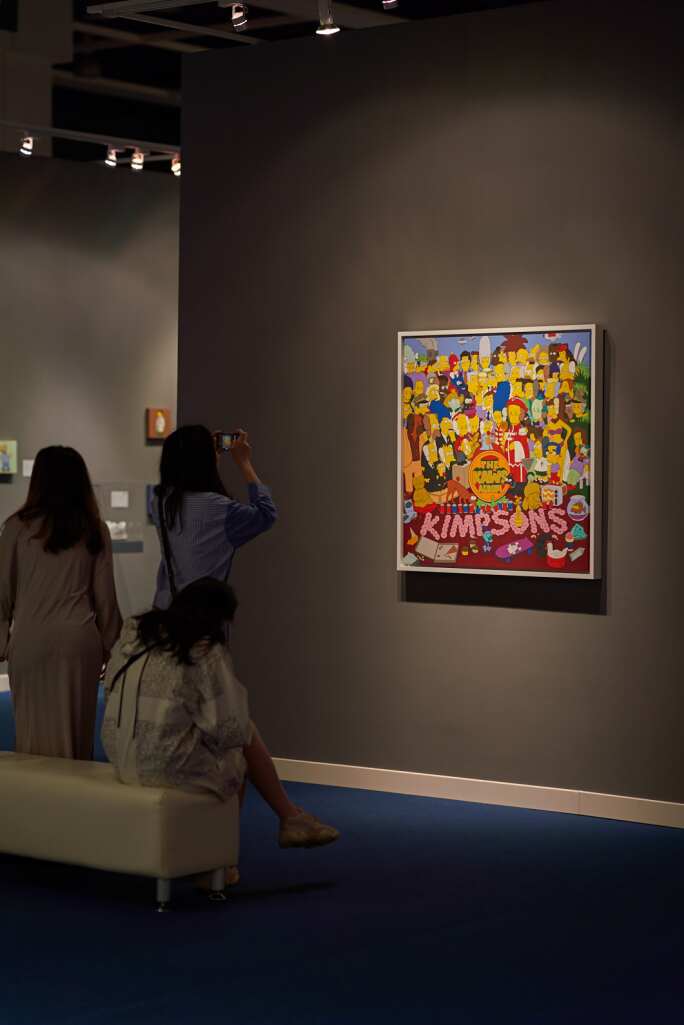
What are some milestones you’ve seen at the helm of Sotheby’s Contemporary Art team in Asia?
It is most certainly a pivotal moment right now in Asia, and it’s an exciting time to be here. The growth of our auctions speaks for itself. Let me provide just three examples. We reached a new world record for Yayoi Kusama this Spring with one of the earliest infinity nets from her oeuvre, Interminable Net #4. It was a real honor for us. In the same evening sale, we made headlines when we topped a new record with Julie Mehretu, another great female contemporary artist. And of course, there was the KAWS record. Our offering is the most diversified it has ever been. Western lots more than doubled estimates to achieve US$53 million, the highest for any auction house in Asia.
Global participation in our Hong Kong auctions is also on the rise. This season recorded a 50% increase in non-Asian bidding across our Contemporary auctions. Beyond achieving stellar prices and new milestones for artists from both the East and the West, this success sets a clear message: Hong Kong has arrived as a true global platform for contemporary art.

What’s driving the demand? Why now?
There is massive potential in Asia. Compared to the more established markets in the West, Asia is still a fledgling market with a base of first-generation collectors whose appetite still has extraordinary potential to grow. Behind only New York and London, Hong Kong is the third-largest art market and continues to expand. A key driver of growth is Asia’s emerging young collector base. Currently, 40% of our new clients in Asia are under 40. This is an extremely positive sign for the health of the market. With their eclectic tastes and novel approaches to art, younger collectors will shape a rich and diversified ecosystem far beyond the obvious tiers of blue-chip art.
What artists or types of art are particularly suited for the market in Asia?
We have been very selective in introducing Western artists to the Asian market, and our strategy has proven successful. Some are very well received in Asia, including George Condo, Jonas Wood, Joan Mitchell, Julie Mehretu, KAWS, Donald Judd, and Andy Warhol, to name a few.
Equally important is the deep untapped potential of Asian contemporary art vis-à-vis Asia as well as the Western collecting community. As the regional market grows, contemporary art from Asia will be exposed to a much larger international audience who will become increasingly versed in the complex and highly diverse sector. The genre is multifaceted, encompassing important artists and movements from China, Korea, and Japan.
Who are some of the more promising Asian artists?
Atsuko Tanaka is one of the most talented artists from postwar Japan whose work has robust art-historical importance but remains undervalued. Her use of electricity and lightbulbs in her 1950s performances and installations predated even the work of American minimalist Dan Flavin, who is known for his fluorescent light installations. Tanaka’s highly conceptual and pioneering work has only begun to receive the attention and recognition it deserves.
Another name to watch is Liu Ye, whose star is swiftly soaring to new heights. Demand for his work has become truly global, as evidenced by the fiercely competitive bidding and stellar prices achieved for the artist at our recent auctions.
There is also significant potential in younger emerging or mid-career names. The critically acclaimed Korean artist Yang Haegue is an excellent example. A fascinating sculpture achieved a new world record for the artist in our Spring 2019 Day Sale.
Your innovative approaches at curated sales has become quite well known. These sales range from scholarly, research-driven auctions to collaborations with pop stars and celebrity collectors. What inspires these events?
Our curating approach reflects the growing scene in Hong Kong and Asia. As an auction house, our relationship with the regional art scene is reciprocal. We are passionate about nurturing and cultivating the collecting community. So, we are inspired by the fresh perspectives of the wider public and the way in which these tastes evolve. Auctions such as “#TTTOP”, “NIGOLDENEYE® Vol. 1” and “Curated: Turn It Up” garnered success not just in terms of actual sales results, but also in engaging a wider audience to the dynamism of contemporary art.

On the other side of that spectrum, we have our academically oriented sales, intended to deepen and enrich the collecting landscape for the genre. These include single artist auctions for postwar Japanese artists Yoshihara Jiro, Morita Shiryu, Yamaguchi Takeo as well as our curated “BRUSHWORK” trilogy. There is still comparatively scant research material in English for postwar Japanese art, and our auctions introduced these important artists to a significant number of Western collectors.
What’s the biggest change the market will face in the next 10 years?
The average age of collectors will be younger. What’s fascinates me is meeting so many new collectors coming into the market, who are learning very rapidly about the art world by travelling and seeing art firsthand or via social media. Collecting will also become more personal. In other words, people will start to curate their own aesthetics and not be bound by conventional categories.







